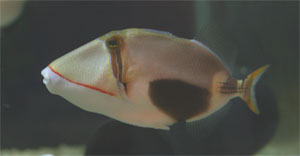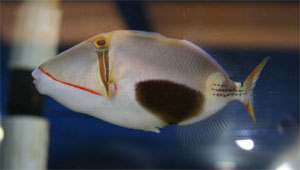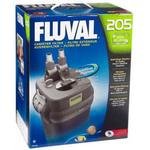|
|
Bursa Triggerfish – Rhinecanthus verrucosus
The bursa triggerfish, also called the White-lined triggerfish and blackbelly triggerfish comes from Indo-Pacific Ocean region. They are a hardy fish that will tolerate less than perfect conditions, however they become aggressive as they mature. These fish are pretty disease resistant. 
Maximum Size: The bursa triggerfish should grow to a maximum size of 9.1 inches
Minimum Tank Size: The minimum tank size should be 55 gallons.
Care Level: The bursa triggerfish is a very hardy fish to maintain. On a scale of 1 –10, (10 being easy) it would rate a “9”. The tank should already be cycled before introducing this fish.
Tank Conditions: Temperature 77-79°F; Specific gravity: 1.021 – 1.024; pH: 8.0 – 8.3; Nitrates should be no more than 20 ppm, however they can tolerate rates as high as 50ppm.
Color: The bursa triggerfish – as picture shows is multi-colored. The key to identifying the Bursa Trigger, are the red and yellow lines on the head joining the eye to the pectoral fin. The fins are almost colorless sometimes with a bronze tint. Males are larger and more colorful than females.
Temperament: This is a good fish as a juvenile. It will more than likely become aggressive to other fish so it should be housed with larger fish and or fish that can handle aggression.
 Reef Compatible: Will attack invertebrates so care should be used. This is a fish best kept in a fish only aquarium Reef Compatible: Will attack invertebrates so care should be used. This is a fish best kept in a fish only aquarium
Diet: The bursa triggerfish is a carnivore – feed foods such as brine-shrimp, chopped shrimp, clams, mussels, and squid. Feed dried and frozen fish food.
Habitat: Provide with plenty room. Good water circulation is important as well as high quality water maintenance. Filtration should include a protein skimmer and activated carbon filtration.
Lighting: Depending on the tank setup you desire. The bursa triggerfish needs no special setup
Compatibility: Triggerfish in general can be kept with boxfish and moray eels and they should not be housed with sharks, rays and small non-aggressive fish such as firefish and cardinalfish and can be a problem if housed with many others – check with your aquarium shop if you plan on buying one of these fish.
|
|
|
|





 Reef Compatible: Will attack invertebrates so care should be used. This is a fish best kept in a fish only aquarium
Reef Compatible: Will attack invertebrates so care should be used. This is a fish best kept in a fish only aquarium